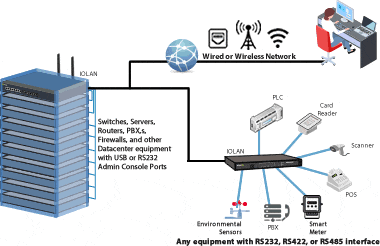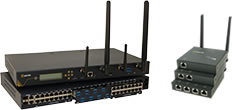Serial over Ethernet Solutions
Understanding the Terminology
If you want to transmit RS232, RS422, or RS485 data across an IP wired or wireless (Cellular or WiFi) network, keep reading – you are in the right place. The terminology used in this area is broad. The purpose of this page is to familiarize you with the terminology and the type of solutions available on the market to meet your needs.
Perle Systems has been a leader in this industry since 1976 and provides Serial to Ethernet and Out-of-Band Management solutions for basic to the most advanced applications.
Everywhere you look for these types of solutions you will find references to Terminal Servers, Serial Servers, Device Servers, and Console Servers. The most common questions is, ‘What is the difference?’ followed closely by, 'Which one do I need?’
What is the difference?
The simple answer – None. It is marketing terminology. Over the years, the leaders in Serial over Ethernet Solutions have launched out new terminology to try to differentiate themselves from the competition. In the end, this marketing strategy has had one result – confusion for you – the customer. However, as time has passed, the main differentiator has come down to the hardware platforms. To help you navigate this marketing maze, here are the simple differentiators that marketing uses to classify products that all, pretty much, do the same thing.
Terminal Servers and Serial Servers
A Terminal Server, also known as Serial Server, is generally positioned as a device that connects devices with a USB, RS232, RS422, or RS485 serial interface to a local area network for transmission of serial data over Ethernet to network server applications. By converting serial data signals into Ethernet (TCP or UDP) packets, and vice versa, they enable reliable data transmission to other devices or network server applications. This is accomplished by encapsulating the serial data in Ethernet packets in a manner that best fits the type of data being transported. It is critical to choose a Terminal Server that can guarantee authentic serial communications and maintain device protocol integrity across Ethernet. Terminal Servers have a physical wired or wireless (LTE or WiFi) network connection on one side, and from 8 to 50 serial ports on the other side in a 1U Rackmount chassis. While some Serial Terminal Servers can be very simple devices, it is best practice to use a Terminal Server with advanced security functionality, data encryption, and user authentication to ensure network data transmissions, and access to network equipment, is protected.
Console Servers and Out-of-Band Management
A Console Server is generally exclusively promoted as an Out-of-Band Management Solution. It enables secure remote console management of any device with a serial or USB console port, including Cisco routers, switches, firewalls, servers, PBXs, and more. This single hardware solution should include integrated Cellular, WiFi, or V.92 modem as a secure alternate route to monitor IT, networking, security and power devices from multiple vendors. While software management tools can be used for performance monitoring, and some remote troubleshooting, they only work when the network is up. The Console Server with integrated Cellular, WiFi, or V.92 modem ensures that on-site infrastructure is accessible, even during system or network outages. They can be used to reconfigure, reboot, and reimage remotely across the internet or WANs to minimized downtime by providing better visibility of the physical environment and the physical status of equipment.
Device Servers
Device Servers are the most difficult to define because this is the ‘newest’ marketing term. Generally a Device Server is any compact Terminal Server or Console Server with 1 to 8 serial ports. The functionality of these products is identical to Terminal Servers and Console Servers. It is really comes down to a device with less than 8 serial ports in a very compact chassis that can be mounted onto a DIN Rail or fit inside another small enclosure. Generally Device Servers are promoted to make M2M communication possible in a wide variety of applications by enabling client access to equipment with an RS232, RS422, or RS485 interface over a wired or wireless (LTE or WiFi) network connection independent of any operating system or proprietary protocol.
Which one do I need?
Perle has revolutionized the serial over Ethernet market by making the choice of products easy for you. We have taken the unique position of making all software features available on all IOLAN Terminal Server, Console Server, and Device Server products. Perle is the first company that will not make you choose a product based on the software features that you may want or need. Every software feature is on every product. You only need to choose your hardware platform to learn more.



